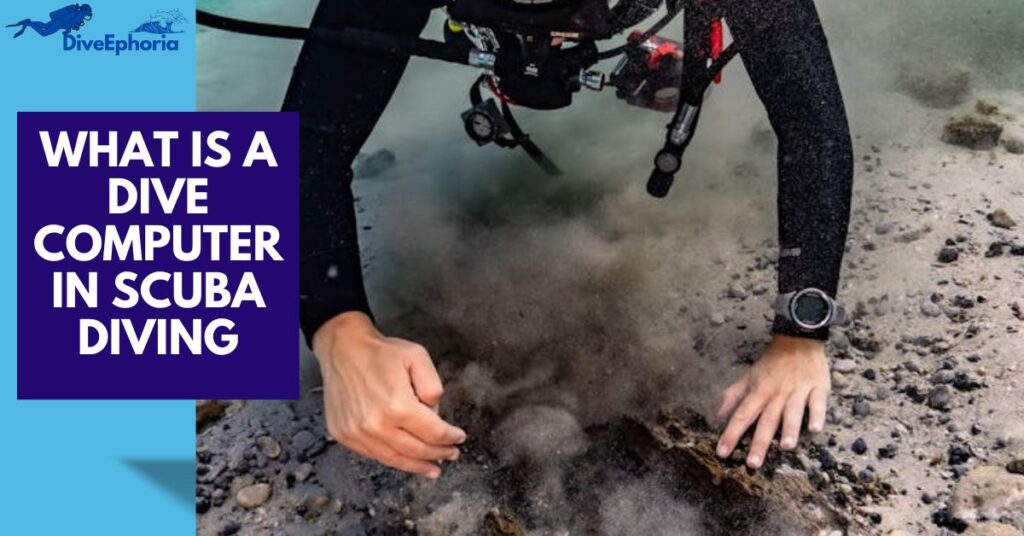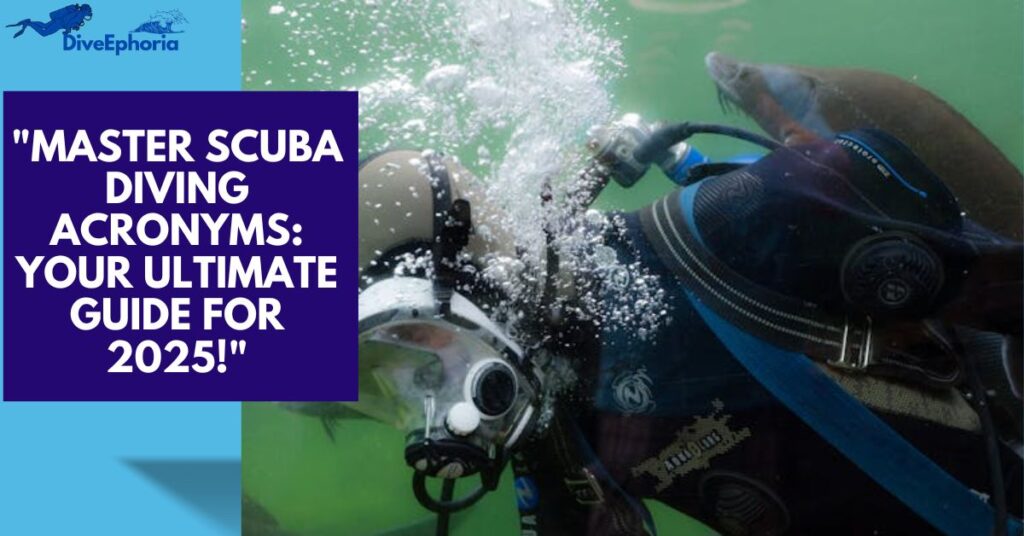
Table of Contents
Introduction
Scuba diving is an exhilarating sport, but its terminology can be overwhelming for beginners and even experienced divers. From equipment abbreviations to training agency acronyms, understanding scuba diving acronyms is essential for safety and communication underwater. In this guide, we break down the most important scuba diving terminology, covering everything from dive gear abbreviations to diving safety acronyms. Whether you’re preparing for certification or looking to brush up on your knowledge, this glossary will help you navigate the world of scuba diving jargon with confidence.
1. Scuba Diving Equipment Acronyms Explained

Whether you’re a beginner just starting your underwater adventures or an experienced diver upgrading your gear, understanding common scuba diving acronyms is crucial. These terms aren’t just industry jargon—they refer to life-supporting equipment and essential safety tools that every diver must know. Below, we break down the most important scuba gear acronyms and what they mean in 2025.
SCUBA – Self-Contained Underwater Breathing Apparatus
Did you know the word “scuba” is actually an acronym? SCUBA stands for Self-Contained Underwater Breathing Apparatus, which refers to the full set of equipment that enables humans to breathe underwater independently. This includes the air tank, regulator, buoyancy control device (BCD), and gauges. Modern scuba gear is more lightweight and streamlined than ever, making it easier for divers to explore deeper and longer with greater safety and comfort.
BCD – Buoyancy Control Device
The Buoyancy Control Device (BCD) is a vital component of any scuba setup. It allows divers to control their buoyancy at various depths by adjusting the amount of air in the BCD bladder. This helps you achieve neutral buoyancy, making it easier to hover in place, ascend slowly, or descend with control. In 2025, many BCDs feature integrated weight systems and smart inflation mechanisms for improved safety and efficiency.
Why It Matters: Without proper buoyancy control, divers risk ascending too quickly or disturbing marine life by crashing into the reef.
CCR – Closed Circuit Rebreather
The Closed Circuit Rebreather (CCR) is a sophisticated system used primarily in technical diving and deep exploration. Unlike traditional open-circuit scuba systems that release bubbles when you exhale, CCRs recycle the exhaled air by scrubbing out the carbon dioxide and adding oxygen as needed. This allows for longer dive durations, stealth diving (minimal bubbles), and greater gas efficiency.
2025 Tech Update: New CCR units feature AI-driven sensors and dive monitoring systems, enhancing both safety and performance.
DPV – Diver Propulsion Vehicle
A Diver Propulsion Vehicle (DPV), often called an underwater scooter, allows divers to travel faster and farther without exhausting themselves. DPVs are especially useful in wreck diving, cave diving, or exploring large reef systems where covering distance efficiently is critical. In 2025, lightweight lithium-powered DPVs with advanced battery management are becoming the norm.
Bonus Tip: Always practice with your DPV in a controlled environment before taking it on deep dives.
SPG – Submersible Pressure Gauge
The Submersible Pressure Gauge (SPG) is a must-have for monitoring your air supply. Connected directly to the first stage of your regulator, the SPG gives a real-time reading of how much air remains in your tank. This information is critical for planning your ascent and ensuring you don’t run out of air underwater.
Modern Dive Tip: Many dive computers now integrate SPG data wirelessly, offering streamlined data display in a single wrist-mounted device.
SMB – Surface Marker Buoy
An SMB (Surface Marker Buoy), often referred to as a safety sausage, is an inflatable tube that divers deploy before ascending. The SMB floats on the surface, alerting nearby boats and dive teams to the diver’s location. It’s especially important when surfacing far from the dive boat or in areas with heavy boat traffic.
2. Scuba Diving Training and Certification Acronyms
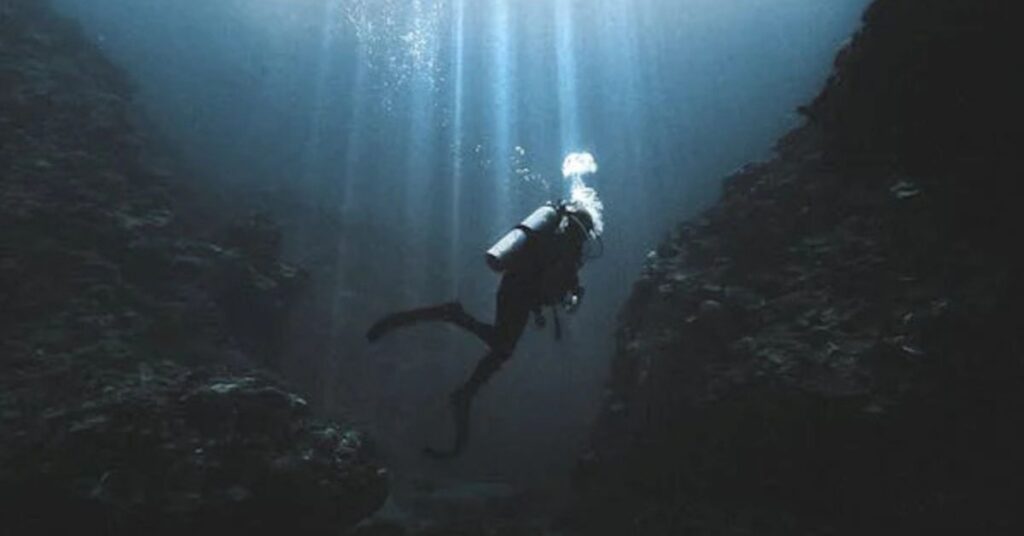
Understanding scuba diving certification acronyms is crucial for any diver, whether you’re just starting your open water journey or pursuing advanced technical training. These organizations provide standardized instruction, uphold safety protocols, and issue certifications recognized globally. Here’s a breakdown of the most trusted and widely recognized scuba diving training agencies as of 2025.
PADI – Professional Association of Diving Instructors
PADI is the largest and most recognized scuba certification agency in the world. With over 29 million certifications issued globally, PADI sets the gold standard in recreational scuba training. Whether you’re taking your Open Water Diver, Rescue Diver, or Divemaster course, PADI’s modular training system is designed for safety, flexibility, and accessibility.
Why Divers Choose PADI:
- Global recognition in over 180 countries
- Comprehensive eLearning platforms
- Emphasis on conservation through programs like Project AWARE
2025 Highlight: PADI has expanded its digital learning tools, including immersive VR simulations for skill mastery before entering the water.
SSI – Scuba Schools International
Scuba Schools International (SSI) is another globally respected dive training agency, offering similar certification paths as PADI. SSI is known for its flexible digital learning, high-quality instructor training, and performance-based progression model. Their certifications are accepted worldwide and are a great choice for divers who value a structured, app-driven approach.
Why Divers Choose SSI:
- Mobile-friendly training via the SSI app
- Free academic materials with affiliated dive centers
- Offers specialties like Night Diving, Enriched Air (Nitrox), and Wreck Diving
NAUI – National Association of Underwater Instructors
NAUI is the oldest non-profit scuba certification agency and is highly respected among recreational and technical divers. NAUI places a strong emphasis on academic depth and dive planning. Their training is often preferred by divers who want a more detailed and rigorous learning experience.
Notable Features:
- Focus on diver empowerment and decision-making
- Offers courses from beginner to Technical Diver Instructor
- Frequently chosen by military, rescue, and public safety dive teams
BSAC – British Sub-Aqua Club
BSAC (British Sub-Aqua Club) is the UK’s national governing body for scuba diving and snorkeling. Unlike other agencies that rely on commercial dive centers, BSAC operates through community-based dive clubs. Training is known for being thorough and is delivered by volunteer instructors over extended timeframes, making it ideal for divers who prefer learning at a steady pace within a social community.
Why BSAC Stands Out:
- Club-based structure encourages teamwork and long-term skill development
- Strong focus on cold water and drysuit diving
- Offers internationally recognized certifications, including crossover options for PADI and SSI divers
2025 Insight: BSAC continues to lead in eco-diving practices, partnering with marine conservation groups across Europe.
3. Essential Scuba Diving Safety Acronyms
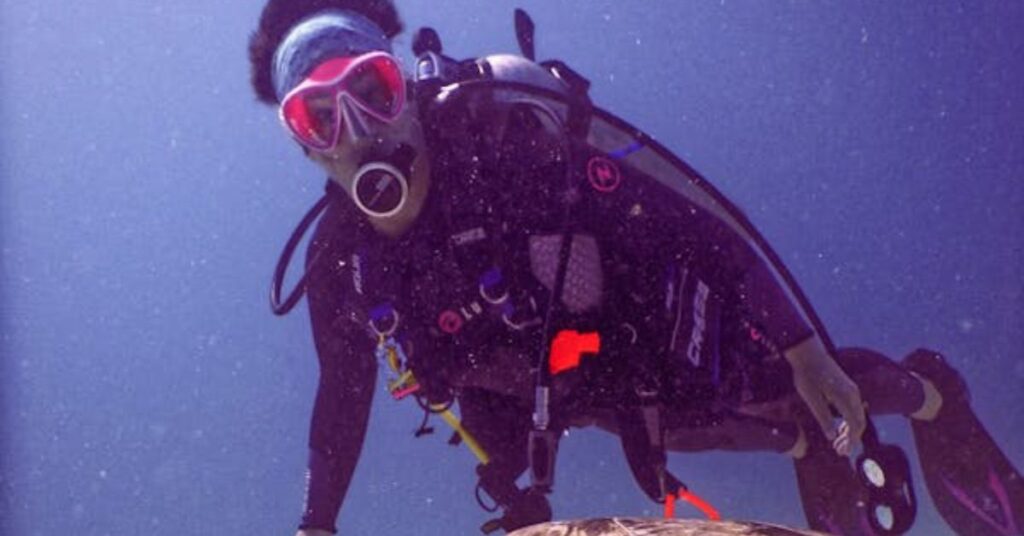
Safety is the cornerstone of any successful scuba dive. Knowing how to handle your equipment is just the beginning—being familiar with critical scuba safety acronyms and procedures can mean the difference between a great dive and a life-threatening emergency. These acronyms serve as essential mental checklists and safety protocols that every diver should memorize and apply before, during, and after every dive.
BWRAF – BCD, Weights, Releases, Air, Final Check
BWRAF is one of the most well-known pre-dive safety checklists. Often remembered with the mnemonic “Burger With Relish And Fries,” this step-by-step routine ensures that all vital scuba gear is functioning and secured properly before you enter the water.
- B – BCD: Check that your Buoyancy Control Device inflates and deflates correctly.
- W – Weights: Confirm weights are present, secured, and easily releasable.
- R – Releases: Ensure all buckles, clips, and tank straps are fastened.
- A – Air: Verify your tank is full, your regulator delivers air, and both primary and alternate air sources are working.
- F – Final Check: A quick head-to-toe check of gear, accessories, and dive computers.
CESA – Controlled Emergency Swimming Ascent
CESA stands for Controlled Emergency Swimming Ascent, a life-saving skill used when a diver runs out of air and must ascend safely without assistance. The key principle is to exhale slowly and continuously while ascending, maintaining control and avoiding lung over-expansion injuries.
When to Use CESA:
- You’re out of air and can’t reach your buddy.
- You’re within a safe depth (usually <30 feet / 10 meters).
- You’ve been trained in this technique during your Open Water course.
NDL – No Decompression Limit
The No Decompression Limit (NDL) is the maximum time a diver can stay at a specific depth without requiring decompression stops during ascent. Staying within your NDL helps avoid decompression sickness (the bends), which can occur if dissolved nitrogen forms bubbles in the bloodstream.
Modern Tip (2025): Use a dive computer with real-time NDL tracking and adjust for multiple dives using multi-level dive algorithms.
MOD – Maximum Operating Depth
MOD stands for Maximum Operating Depth, referring to the deepest depth a diver can safely reach based on their breathing gas mixture—especially important when using Enriched Air Nitrox (EANx) or Trimix. Exceeding your MOD increases the risk of oxygen toxicity, a serious and potentially fatal condition.
Formula: MOD is calculated based on the gas mix and partial pressure of oxygen (PPO2). Most recreational divers aim for a PPO2 of 1.4 ATA.
RDP – Recreational Dive Planner
Before dive computers became mainstream, divers used the Recreational Dive Planner (RDP)—a table-based system for calculating depth, bottom time, and surface intervals. While modern divers use digital alternatives, learning how to use an RDP is still part of foundational scuba training.
Why It’s Still Relevant:
- Teaches dive theory and nitrogen absorption basics
- Serves as a manual backup for dive planning
SORTED – Signal, Orientate, Regulator, Time, Equalize, Descend
The acronym SORTED is a descent checklist ensuring a safe and organized start to your dive. Using this simple mental guide helps prevent common beginner mistakes like forgetting to equalize or descending too quickly.
- Signal: Communicate readiness with your buddy.
- Orientate: Take note of your surroundings and reference points.
- Regulator: Confirm it’s properly in your mouth and breathing smoothly.
- Time: Start your dive timer or check your computer.
- Equalize: Begin equalizing your ears early and often.
- Descend: Begin a slow, controlled descent.
STELA – Signal, Time, Extend, Look & Listen, Ascend
STELA is the counterpart to SORTED, focused on conducting a safe ascent from your dive. Following this process helps reduce the risk of decompression illness, ear barotrauma, and missed safety stops.
- Signal: Communicate with your buddy before ascending.
- Time: Monitor ascent speed (no faster than 9 meters/30 feet per minute).
- Extend: Raise your arm and SMB if needed.
- Look & Listen: Watch for boats and listen for surface noise.
- Ascend: Maintain a steady, controlled rise with a safety stop at 5 meters for 3 minutes.
VENTID – Symptoms of Oxygen Toxicity
VENTID is a safety acronym that helps divers recognize the early symptoms of oxygen toxicity, especially important for those using high oxygen mixes like Nitrox or during deep dives with technical gas blends.
- V – Visual disturbances (tunnel vision, blurring)
- E – Ear ringing (tinnitus)
- N – Nausea
- T – Twitching (especially facial muscles)
- I – Irritability
- D – Dizziness
Pro Safety Tip: If you notice any of these symptoms, ascend to a shallower depth immediately and abort the dive.
4. Medical and Emergency Acronyms in Diving
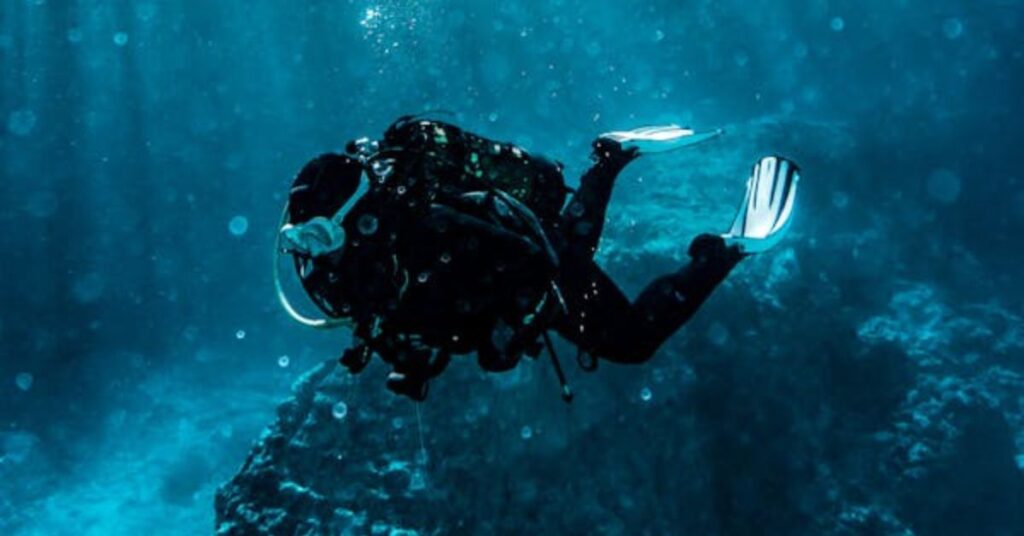
When it comes to scuba diving, knowing your gear and dive plans is only part of the equation. Understanding medical and emergency response acronyms is equally important, especially in situations where seconds count. These acronyms represent critical life-saving procedures and conditions that every diver—regardless of experience level—should be familiar with. They can help prevent serious injury, promote fast response in emergencies, and even save lives.
DCI / DCS – Decompression Illness / Decompression Sickness
DCI (Decompression Illness) and DCS (Decompression Sickness) are umbrella terms for conditions that result from inadequate off-gassing of nitrogen during or after a dive. Commonly referred to as “the bends,” this condition occurs when dissolved nitrogen forms bubbles in the bloodstream or tissues due to rapid ascent or exceeding no decompression limits (NDLs).
Symptoms of DCI/DCS Include:
- Joint and muscle pain (especially in the limbs)
- Dizziness or confusion
- Fatigue or weakness
- Numbness or tingling
- Difficulty breathing or chest pain
Immediate Response:
- Administer 100% oxygen
- Keep the diver lying down and hydrated
- Transport to a hyperbaric chamber for recompression therapy
AED – Automated External Defibrillator
An AED (Automated External Defibrillator) is a portable life-saving device used to restore a normal heart rhythm in individuals experiencing sudden cardiac arrest. In remote dive locations, access to emergency services may be limited, so having an AED on-site or on the dive boat can be a literal lifesaver.
Key Features of an AED:
- Delivers a controlled electric shock to the heart
- Provides voice prompts and visual instructions
- Designed for use by trained or untrained bystanders
2025 Pro Tip: Many liveaboard dive boats and resorts now require crew AED certification, especially in areas with limited emergency medical access.
CPR – Cardiopulmonary Resuscitation
CPR (Cardiopulmonary Resuscitation) is a core life-saving skill taught in all diver first aid and rescue training programs. It involves a combination of chest compressions and rescue breaths to maintain blood and oxygen flow to vital organs during cardiac arrest or drowning scenarios.
When to Perform CPR:
- The diver is unresponsive and not breathing
- There’s no detectable pulse
- The diver has suffered a near-drowning incident
Standard CPR Ratio (2025 Guidelines):
- 30 compressions to 2 rescue breaths
- Continue until help arrives or an AED is available
EFR – Emergency First Response
Emergency First Response (EFR) is a first aid and CPR certification course recognized globally and required for advanced scuba training, such as the PADI Rescue Diver and Divemaster courses. EFR courses are open to both divers and non-divers and focus on primary care (CPR), secondary care (first aid), and automated defibrillator (AED) use.
EFR Course Highlights:
- Covers adult, child, and infant CPR
- Teaches primary and secondary assessments
- Includes training for AED use and emergency oxygen administration
- Valid for 24 months, with refreshers recommended
Why EFR Matters for Divers:
- Prepares divers to respond to in-water and surface emergencies
- Builds confidence in handling serious injuries, near-drowning, and shock
- Meets prerequisites for multiple PADI pro-level certifications
Dive Prepared: Knowledge Saves Lives
Medical emergencies in scuba diving are rare, but when they happen, your preparation makes all the difference. Whether you’re diving with a buddy or guiding a group, being trained in these procedures—and understanding these acronyms—could save a life. Every diver should strive for proactive safety awareness, ongoing first aid training, and regular skills refreshers to stay confident and competent both in and out of the water.
Conclusion
Understanding scuba diving acronyms isn’t just about memorizing letters—it’s about diving smarter, safer, and with greater confidence. Each acronym you learn represents critical concepts in equipment handling, safety protocols, medical readiness, and certification pathways that form the backbone of responsible diving.
Whether you’re just starting out or already logging advanced dives, these essential terms are key to:
- Improving underwater communication
- Performing accurate pre-dive safety checks
- Responding effectively in emergencies
- Planning dives using proven tools and safety standards
- Navigating gear setups and dive boat procedures with ease
From BWRAF to DCI, MOD to EFR, mastering this scuba diving terminology will make you a more capable and reliable diver—and a better dive buddy. In fact, many dive professionals say the difference between a good diver and a great one often comes down to knowledge, preparedness, and awareness. These acronyms cover all three.
Ready to Take Your Diving Knowledge Deeper?
If you’ve made it this far, chances are you’re serious about diving. Why stop here? Enroll in a professional scuba diving course with PADI, SSI, or NAUI to further your education, refine your skills, and explore deeper waters safely. These certification programs will guide you through advanced dive theory, practical skills, and emergency training—all while helping you gain a broader understanding of the dive community and environment.
- For beginners: Try an Open Water Diver Course and start diving independently.
- For certified divers: Consider the Advanced Open Water, Rescue Diver, or Nitrox Enriched Air courses.
- For aspiring professionals: Dive into Divemaster or Instructor Development Courses (IDC) and turn your passion into a career.
Dive Smarter. Dive Safer. Dive Informed.
The underwater world is breathtaking, mysterious, and sometimes unpredictable—but with the right knowledge, it becomes your playground. Keep learning, stay sharp, and share these scuba diving acronyms with your dive buddies. Because the more you know, the safer and more rewarding every dive becomes.
FAQs About Scuba Diving Acronyms
What does SCUBA stand for?
SCUBA stands for Self-Contained Underwater Breathing Apparatus.
What is the most important acronym for beginner divers?
BWRAF (BCD, Weights, Releases, Air, Final Check) is crucial for every dive as it ensures equipment and safety readiness.
What is NDL in diving?
NDL (No Decompression Limit) is the maximum amount of time a diver can stay at a specific depth without requiring decompression stops.
What does PADI stand for?
PADI stands for Professional Association of Diving Instructors, one of the largest diving certification agencies.
What is the difference between DCS and AGE?
DCS (Decompression Sickness) occurs due to nitrogen bubbles forming in tissues after a rapid ascent.
AGE (Arterial Gas Embolism) results from expanding air in the lungs that enters the bloodstream, often due to holding breath while ascending.


